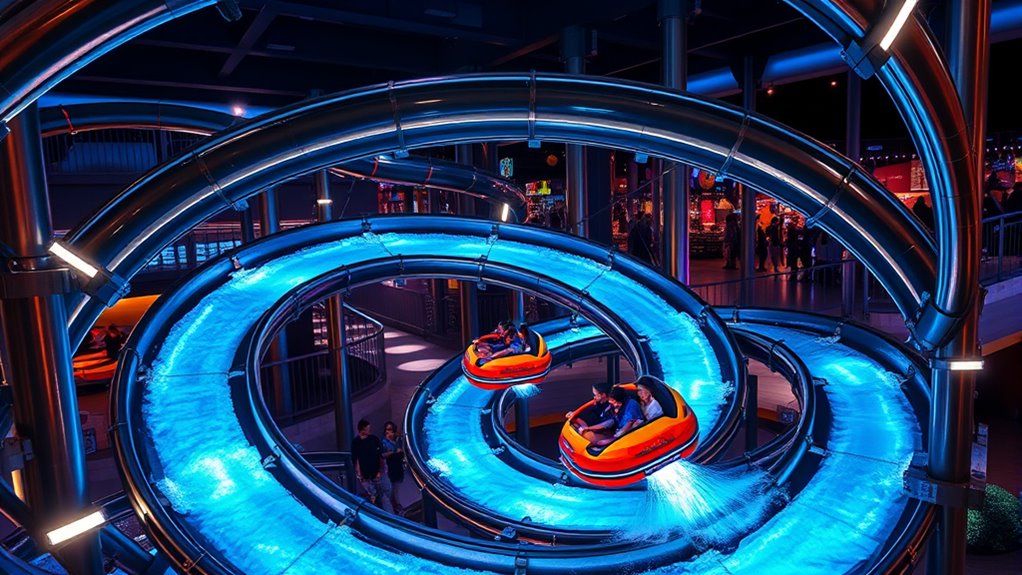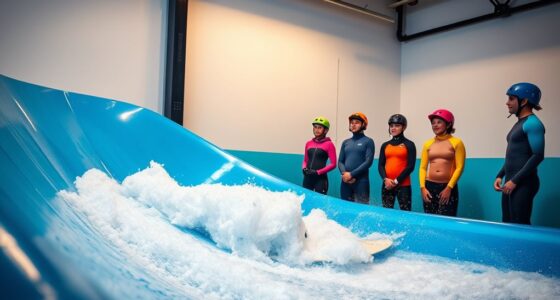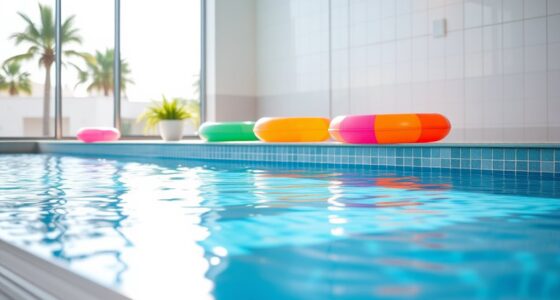Indoor water coasters use advanced propulsion systems like linear induction motors and hydromagnetic technology to move rafts smoothly and efficiently. These systems generate magnetic fields that push or pull the rafts along the track, even uphill, without contact. They also incorporate safety features, durable materials, and smart controls to optimize performance and reduce maintenance. If you keep exploring, you’ll discover how these innovations create exciting and safe water coaster experiences that are changing the industry.
Key Takeaways
- Indoor water coasters use advanced propulsion systems like water jets, magnetic, or hydromagnetic methods to move rafts smoothly along the track.
- Magnetic systems utilize linear induction motors or magnets under the flume to propel and accelerate rafts without contact.
- Water jets and channel-based systems generate force through sequential water streams, providing powerful propulsion and ride control.
- Control systems monitor ride progress, activating propulsion only when needed to optimize energy use and ensure safety.
- Ride design incorporates simulation and safety testing to ensure thrilling, safe experiences with durable materials and integrated safety features.
Propulsion Technologies in Indoor Water Coasters
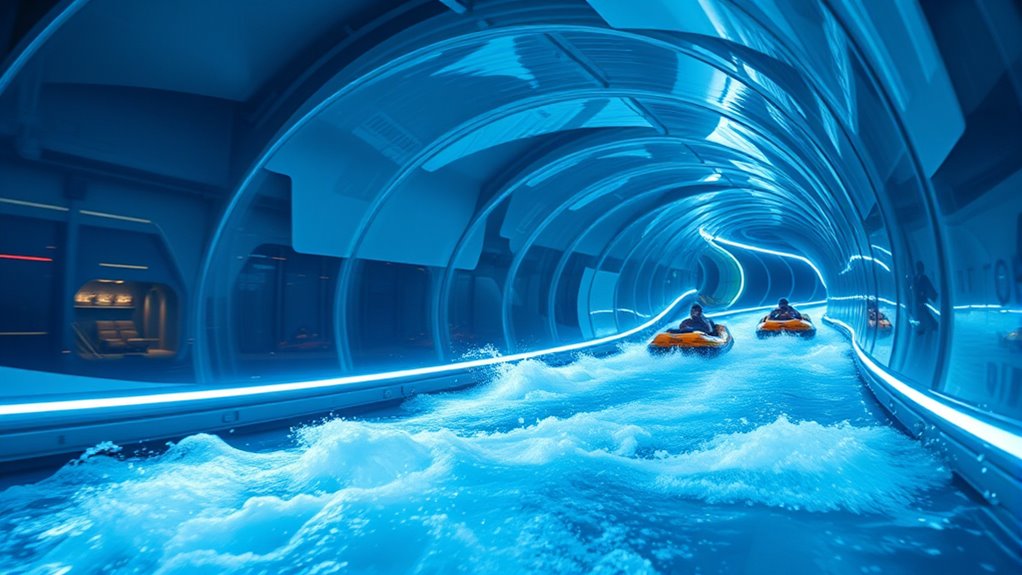
Propulsion technologies are the heart of indoor water coasters, driving the rafts smoothly and efficiently along the slides. Water jets are common in traditional systems, pushing the rafts forward using powerful streams of water. Some coasters, like ProSlide’s RocketBLAST, use sequential water jets for consistent force, ensuring a smooth ride. These systems often feature channels on the sides of the boats to capture dynamic water energy, boosting efficiency. Zone-blocking technology allows multiple rafts to operate simultaneously, increasing capacity. Conveyor systems also help by continuously loading boats, maintaining a steady flow. These innovations make rides more thrilling while optimizing energy use. Modern propulsion methods focus on delivering a seamless experience and higher throughput, making indoor water coasters both exciting and efficient. ProSlide’s patented water propulsion tech captures water’s energy more effectively, further enhancing ride performance and reliability. Additionally, advancements in wave and wind energy capture techniques can be adapted to improve propulsion efficiency in water-based attractions.
The Role of Linear Induction Motors and Hydromagnetic Systems

Linear induction motors and hydromagnetic systems use magnetic fields to propel rafts efficiently and smoothly uphill. They convert electrical energy directly into propulsion forces, making the ride more exciting and energy-efficient. This technology is patented and highly efficient, and it allows for precise control of raft movement, enhancing safety and ride dynamics. Additionally, the use of magnetic propulsion reduces mechanical wear and maintenance requirements, contributing to the system’s longevity. Understanding how these systems work reveals how they enhance the overall water coaster experience.
Magnetic Propulsion Mechanics
Magnetic propulsion in water coasters relies on advanced electromagnetic systems to accelerate rafts smoothly and efficiently. Linear induction motors (LIMs) generate magnetic fields when energized, which interact with metal plates attached to the rafts. This interaction produces a force that propels the raft forward or uphill without physical contact, ensuring a contactless ride. Hydromagnetic systems expand on this by placing magnets underneath the fiberglass flume, creating magnetic fields that engage with metal plates in the rafts for powerful, on-demand acceleration. These systems adjust force in real-time, providing consistent speed and smooth launches. Because they have no moving parts, LIMs and hydromagnetic systems reduce maintenance, increase safety, and enable higher ride capacities. This technology offers a seamless, high-speed experience similar to roller coaster launches. The efficiency of these systems can be enhanced with precise control algorithms, allowing for more dynamic ride experiences. Additionally, the use of advanced electromagnetic technology ensures that these systems operate reliably over extended periods.
Power Source Efficiency
Efficient power sources are key to maximizing the performance and sustainability of indoor water coasters. Linear Induction Motors (LIM) propel rafts uphill using electromagnetic reactions between magnets and metal plates, activating only when needed. This contactless system offers on-demand power, resulting in faster climbs and a more exhilarating ride while conserving energy. Hydromagnetic systems, like those in HydroMAGNETIC coasters, utilize sensors and advanced controls to optimize water and energy use, boosting efficiency by up to 60%. Variable Frequency Drives (VFDs) and Variable Speed Pumps (VSPs) further enhance energy savings by adjusting motor and pump speeds based on demand, reducing power consumption by over half. Proper maintenance of filters and components] ensures these systems operate at peak efficiency and longevity. Implementing these technologies not only improves ride performance but also reduces maintenance costs and downtime. Together, these technologies lower operating costs, extend equipment lifespan, and minimize environmental impact, ensuring a sustainable, high-performance ride experience.
Ride Experience Dynamics
You’ll notice that the thrill of a water coaster often hinges on how smoothly and quickly the rafts accelerate uphill, and this is where Linear Induction Motors (LIMs) and hydromagnetic systems play an essential role. LIMs use electromagnetic propulsion to propel rafts without physical contact, creating powerful magnetic fields that interact with metal plates on the rafts. This contactless technology reduces wear, boosting durability and efficiency. electromagnetic propulsion reduces mechanical parts, leading to lower maintenance costs and longer-lasting components. Hydromagnetic systems combine LIM technology with water coasters for optimized propulsion, providing rapid acceleration and variable speeds that enhance your ride experience. The high force density of LIMs allows for quick launches over short distances, delivering smooth, controlled thrills. Overall, these systems ensure a safe, reliable, and exhilarating ride by seamlessly integrating advanced electromagnetic propulsion with thematic design.
How Magnetic Fields Drive the Rafts Forward
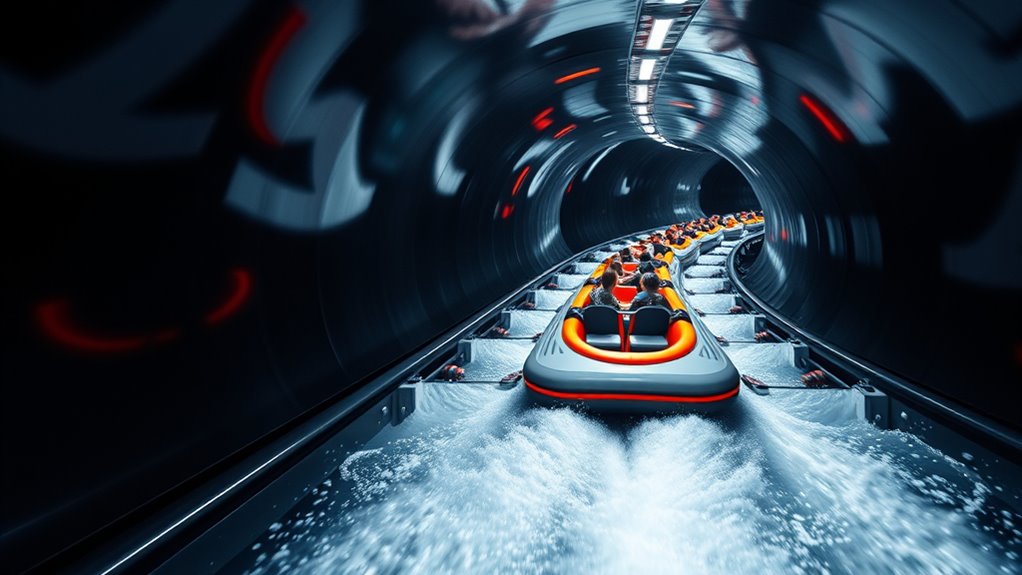
You can see how magnetic fields push the rafts forward by interacting with metal plates underneath. As the stators generate a moving magnetic wave, eddy currents in the plates create opposing fields that produce a forward force. This system allows for real-time adjustments, ensuring smooth acceleration and safe control throughout the ride. Additionally, the precise control of magnetic fields helps prevent security vulnerabilities, maintaining a safe environment for riders.
Magnetic Interaction Principles
Magnetic fields generated by linear induction motors (LIMs) are the key to propelling water coaster rafts without physical contact. These fields interact with the raft’s conductive aluminum reaction plate, creating eddy currents that produce opposing magnetic fields. This interaction results in attractive and repulsive forces that push or pull the raft forward and uphill seamlessly. The process involves strong magnetic flux from energized copper coils wrapped around iron cores, cycling via high-voltage AC power sources. As the magnetic fields move along the LIM’s segmented stators, they induce continuous forces on the raft. Here’s what you need to know:
- Traveling magnetic fields induce eddy currents in aluminum plates
- Opposing magnetic fields generate propulsive forces
- No contact, reducing wear and maintenance
- Magnetic flux cycles rapidly for smooth acceleration
- Power levels adapt to ride needs for efficiency
Real-Time Force Adjustment
The efficiency of indoor water coasters relies heavily on the ability to precisely control the magnetic fields that propel the rafts. With real-time force adjustment, you can instantly modify power levels to match operational needs, ensuring smooth acceleration and deceleration. The system’s advanced control mechanisms monitor the ride’s progress, activating Linear Induction Motors (LIMs) only when necessary—typically around 2.5% of the time between dispatches—saving energy. Because the propulsion is contactless, wear and tear are minimized, and energy losses are reduced through direct electromagnetic conversion. This dynamic control enhances ride safety and performance, providing a seamless experience. The ability to adjust magnetic forces on the fly makes the system highly responsive, efficient, and capable of delivering a thrilling ride with optimized energy use. Additionally, ongoing AI safety measures are crucial to prevent malfunctions and ensure the system operates reliably under varying conditions.
Design Elements for Safety and Efficiency

Designing indoor water coasters involves integrating advanced technology and thoughtful layout choices to guarantee rider safety and operational efficiency. You’ll use simulation software to model rider paths, accelerations, and fall risks before construction, ensuring all slide geometry meets safety standards. Adjustments to slide shapes and directions are made based on these reports to comply with regulations. CAD tools help plan layouts that minimize blind spots and optimize staff positioning for surveillance. Simulations also identify ideal water flow and nozzle placement to reduce humidity and maintenance issues. Additionally, digital models allow virtual testing of emergency scenarios, integrating quick response protocols. Incorporating educational safety standards into the design process helps ensure comprehensive protection for all riders.
Innovative Materials and Structural Considerations

Innovative materials play an essential role in ensuring the safety, durability, and aesthetic appeal of indoor water coasters. You’ll find fiberglass components made with premium virgin polyester resins and glass reinforcement, providing strength and a smooth finish. Resin Transfer Moulding (RTM) fiberglass offers enhanced durability and easier cleaning compared to open mould variants. Composite materials, combining glass fiber and resin, are common for water park equipment, while steel components like ASTM-A36 steel support the structure’s framework. UV-resistant gel coatings, approved by FDA and NSF, protect surfaces from water and sun exposure, maintaining color and integrity over time. The support structures are typically made of steel, which are carefully selected for durability, safety, and visual appeal, ensuring your water coaster remains safe, attractive, and easy to maintain, even after heavy use. Additionally, innovative structural designs incorporate advanced engineering principles to optimize flow dynamics and safety features, enhancing the overall guest experience.
Future Trends and Technological Advancements
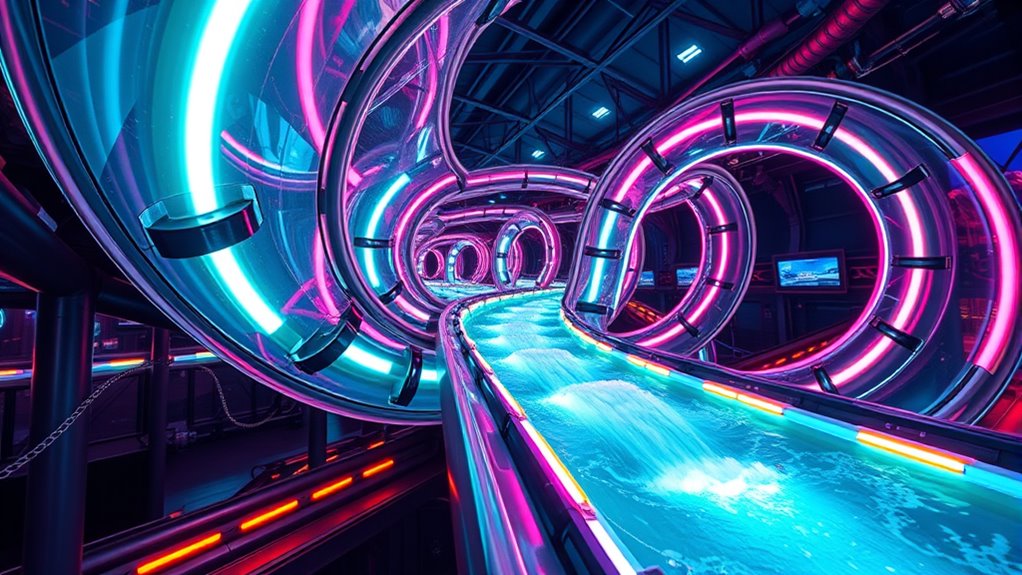
Advancements in technology are transforming indoor water coasters into immersive and dynamic attractions. You’ll see innovations that blend digital worlds with physical rides, elevating the experience. For example:
- AR & VR Integration: Overlay digital visuals and stories onto rides, making each journey interactive.
- Themed Environments: Projection mapping and synchronized effects create fully immersive story worlds.
- Personalized Experiences: AI adjusts ride intensity, lighting, and themes based on your preferences or biometrics.
- Mixed Reality Zones: Shift from physical to virtual challenges, blending real motion with digital play.
- Smart Tracking & Automation: RFID systems and AI optimize throughput, monitor safety, and enable gamified experiences.
- Tuning and customization techniques, similar to vehicle tuning, are also being explored to enhance ride performance and rider engagement.
These advancements make indoor water coasters more engaging, safe, and eco-friendly, promising a future of exciting innovations.
Frequently Asked Questions
How Do Indoor Water Coasters Differ From Outdoor Versions?
You’ll find indoor water coasters are more controlled than outdoor ones, operating year-round regardless of weather. They feature climate control, making your ride comfortable and predictable, while their smaller size allows for immersive theming and advanced effects. Maintenance is easier, and safety measures are more consistent. Although they may cost more to build, they boost tourism and local economy, offering a reliable, exciting experience no matter the season.
What Safety Measures Prevent Rider Injury During High-Speed Launches?
During high-speed launches, safety measures include strict age, height, and weight restrictions to prevent injuries. Staff supervise the ride, giving clear instructions and signals before launch. Regular inspections and maintenance guarantee the slide’s condition, while surveillance systems monitor rider behavior. Emergency procedures are in place, with first aid available and protocols for weather-related shutdowns, all designed to keep you safe and prevent accidents during these thrilling, fast launches.
How Are Ride Capacities Increased With Propulsion Technology?
You can increase ride capacity with propulsion technology by utilizing zone-blocking systems that let multiple boats run simultaneously without collisions. Conveyors and water jets speed up loading and unloading, reducing wait times. Boats with hydrodynamic designs, like side channels and cup-shaped pockets, boost propulsion efficiency and speed. These innovations, combined with hybrid systems, enable steeper, faster rides, accommodating more guests per hour while maintaining safety and ride quality.
What Maintenance Is Required for Electromagnetic Propulsion Systems?
Research shows electromagnetic propulsion systems can operate for over 10,000 hours before requiring major maintenance. You need to regularly inspect thrusters for erosion, contamination, or wear, replacing components like coils or magnets when necessary. Check power electronics for thermal stress, replacing capacitors and transistors as they degrade. Monitor batteries and energy storage, swapping them out when capacity drops. Keep systems clean, calibrated, and update firmware to guarantee peak, reliable performance.
Are There Environmental Impacts Associated With Indoor Water Coaster Operations?
Yes, there are environmental impacts from indoor water coaster operations. You should know that they use significant water, but most is recirculated to reduce waste. Energy consumption is high for heating and cooling, which can generate greenhouse gases. Chemical treatments pose health risks, and waste like plastics can harm the environment if not managed properly. However, many parks are adopting sustainable practices like water recycling, energy efficiency, and waste reduction to lessen these impacts.
Conclusion
By understanding how propulsion technologies, magnetic systems, and innovative materials work together, you can appreciate the engineering marvels behind indoor water coasters. These rides blend safety with excitement, efficiency with innovation, and design with technology. As advancements continue, you’ll see even more thrilling, sustainable, and safe experiences. Embrace the future of indoor water coasters—where science and adventure unite, where safety and excitement intertwine, and where innovation propels you into new heights of fun.

